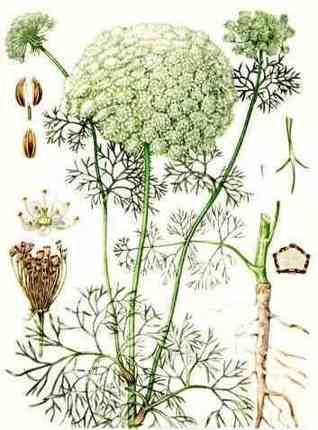IMMI zubnaya – Ammi visnaga
Herbaceous biennial plant height 1 m, families zontichnыh (Umbelliferae). It grows in the Caucasus. For medical purposes, harvest the fruits of plants.

The chemical composition of ammi tooth
Fruits SDC dental contain fatty oils (more 20 %), essential oil and flavonoids (in particular, akacetin). The most biologically active compound is a plant visnamin (kelllïn), which belongs to the group of furanohromona number benzopirona. Also visnamina, from SDC dental allocated Visnadine, visnagin, samidin, kellinol, kellakton and other biologically active compounds.
Pharmacological properties ammi tooth
The amount of biologically active substances antispasmodic plant determines the general direction of the pharmacological activity of ammi tooth. Antispasmodic effect was observed in the experimental study infusions and plant extracts. The amount of active ingredients from the fruit ammi tooth has spasmolytic properties with respect to smooth muscle organs, especially pronounced relaxing effect on the muscles of the ureters plants.
Contained in the plant visnamin furocoumarins has a broader spectrum of pharmacological activity. He has a general antispasmodic action: Expands coronary vessels of the heart and improves coronary blood flow, It lowers the tone of the vascular wall and the gall bladder and ureters, expands bronchial lumen. Substance is rapidly absorbed by the domestic use and has a sedative effect on the central nervous system, potentiates the action of barbiturates. This substance has also photosensitizing effect, expressed in raising the level of sensitivity of the skin of laboratory animals to ultraviolet rays. This effect is superior to these photosensitizing agents, the extract of psoralen and kostyankovoy meladinin.
Furokumarin visnadin, contained in the plant, close to the pharmacological activity of visnaminu. The compound acts primarily on the cardiovascular system. Visnadine has distinct koronarorasshiryayuschee, moderate inotropic effect on the heart, substantially without changing the level of blood pressure in laboratory animals.
Application SDC dental medicine
The most widely used drug Kellin, which is the most active antispasmodic, isolated from ammi tooth. The drug is prescribed for chronic coronary insufficiency, atheromatous- sclerotic cardiosclerosis, asthma, intestinal cramps and stomach. Kellin has no cupping action, he was appointed as a prophylactic measure in the treatment of pain in order to prevent attacks. Bronchial asthma drug also suppresses. Prophylactic his bronchial asthma leads to alleviate symptoms.
With long-term exchange application Kellin (for a month or more) patients, glaucoma partial narrowing of the visual field, a marked expansion of the field of view. No significant effect of the drug on the intraocular pressure and visual acuity is not observed.
With long-term use and overdose possible nausea Kellin, vomiting, allergic skin rashes and deterioration in general health, are usually quickly after discontinuation of the drug. Kellin contraindicated in severe circulatory failure.
Visnadine in medical practice has not found wide application. The therapeutic efficacy of the drug observed in France for the treatment of patients with heart failure, kardiosklerozom, in some heart diseases and myocardial infarction. Patients noted to improve the general state-of, significantly reduced pain. The most effective use Visnadine in combination with cardiac glycosides, metabolites, and anticoagulants.
Avisan used primarily in patients with a tendency to spasms of the smooth muscles of the ureters, urolithiasis, renal colic, and also as an antispasmodic, facilitating ureteral catheterization. The drug was well tolerated, However, in some cases, possible idiosyncrasy and dyspepsia, especially in violation of the gastrointestinal tract. After the cancellation of avisana and dose reduction side effects disappear quickly.
Formulations, Dosage and administration of drugs ammi tooth
Kellïn -White or slightly yellow crystalline powder, bitter taste. Very slightly soluble in water, little - in alcohol. The dose for adults: 0,02 g (sometimes 0,04 g) on reception 3-4 times per day. When angina treatment 2-3 weeks. The therapeutic effect is usually observed after 5-7 days after initiation of treatment. If necessary, repeat the treatment. It may be administered in the form of suppositories. Higher doses for adults inside: single 0,04 g, daily 0,12 g.
Avisan - Yellow-brown amorphous powder bitter taste with a weak peculiar smell. Very little is soluble in water and 95 % alcohol, Insoluble 50-60 % alcohol. Hygroscopic. Is the inside of 0.05-0.1 g 3-4 times daily after meals. The course of treatment 1-3 weeks.
Available in tablets, coated. Store in a dry, protected from light.
